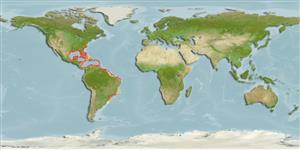Actinopterygii (Straalvinnigen) >
Pleuronectiformes (Flatfishes) >
Cynoglossidae (Tonguefishes) > Symphurinae
Etymology: Symphurus: Greek, syn, symphysis = grown together + Greek, oura = tail (Ref. 45335); diomedeanus: Named for the Greek hero in the Trojan Was, Diomedes.
Omgeving / Klimaat / Range
Ecologie
; marien rifbewoner; diepteverspreiding 6 - 263 m (Ref. 5951), usually 21 - 80 m (Ref. 26268). Subtropical, preferred ?; 36°N - 40°S, 98°W - 35°W (Ref. 26268)
Western Atlantic: Canada (Ref. 5951) to north of Cape Hatteras, North Carolina through the Gulf of Mexico and the Caribbean Sea, inner continental shelf of South America to about Isla de Flores, Uruguay.
Size / Gewicht / Leeftijd
Maturity: Lm ? range ? - ? cm
Max length : 22.0 cm TL mannelijk/geslacht niet bekend; (Ref. 35237); common length : 18.0 cm TL mannelijk/geslacht niet bekend; (Ref. 3716)
Dorsale stekels (totaal): 0; Dorsale zachte stralen (totaal): 90-92; Anale stekels 0; Anale zachte stralen: 73 - 77
Does not usually occur in shallow coastal or estuarine waters (Ref. 26268). Found on muddy bottoms. Feeds mainly on various benthic invertebrates particularly crabs and polychaete worms (Ref. 35237).
Life cycle and mating behavior
Geslachtsrijpheid | Voortplanting | Kuitschieten | Eieren | Fecundity | Larven
Robins, C.R. and G.C. Ray, 1986. A field guide to Atlantic coast fishes of North America. Houghton Mifflin Company, Boston, U.S.A. 354 p. (Ref. 7251)
Status op de Rode Lijst van het IUCN (Ref. 115185)
CITES (Ref. 94142)
Not Evaluated
Gevaarlijk voor mensen
Harmless
Gebruik door de mens
Visserij: van potentieel belang
Meer informatie
Populaire namenSynoniemenMetabolismePredatorsEcotoxicologieVoortplantingGeslachtsrijpheidKuitschietenFecundityEierenOntwikkeling van de eieren
ReferentiesAquacultuurAquacultuurprofielKweeklijnenGeneticaAlleelfrequentiesErfelijkheidZiektenVerwerkingMass conversion
Tools
Speciale rapporten
Download XML
Internet-bronnen
